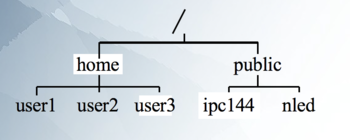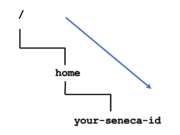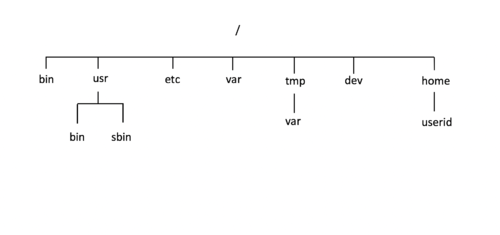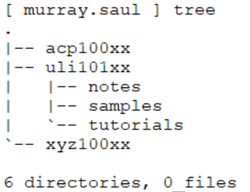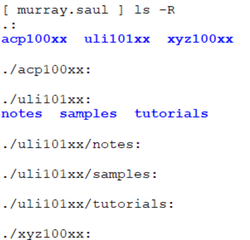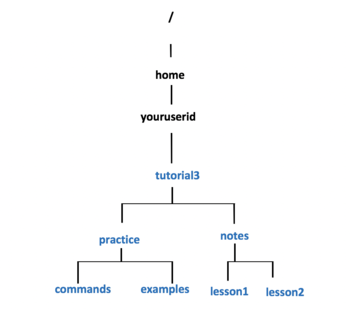Difference between revisions of "OPS705 Lab 2 (2227)"
| Line 215: | Line 215: | ||
Proceed to the next investigation. | Proceed to the next investigation. | ||
| − | =INVESTIGATION 2: | + | =INVESTIGATION 2: Absolute / Relative / Relative-to-Home Pathnames= |
| − | + | The best way to learn about different types of file pathnames is to use them while issuing Linux commands and see which pathnames (or combination of pathnames) is the most efficient (i.e. requiring the least number of keystrokes). | |
| − | + | In the following investigation (Parts 1-3), you will create the exact same directory structure each time, but using a different path type. | |
| − | + | First, let's confirm: | |
| + | # Connect to your CentOS VM's CLI | ||
| + | # Issue a command to confirm you are located in your '''home''' directory. | ||
| − | + | == Part 1: Using Absolute Pathnames == | |
| + | [[Image:dir12.png|right|350px|thumb|In this investigation, you will create the blue sections of this tree diagram.]] | ||
| + | Let's create the following directory structure under your home directory by issuing the <code>mkdir</code> command using only '''absolute''' pathnames. | ||
| − | + | # Issue the following Linux command to create the directory structure displayed to the right using absolute pathnames: <code> mkdir -p /home/youruserid/tutorial3/practice/commands /home/youruserid/tutorial3/practice/examples /home/youruserid/tutorial3/notes/lesson1 /home/youruserid/tutorial3/notes/lesson2</code> | |
| + | #* ''NOTE: Just continue typing and let the text continue of separate lines. Remember to replace the text "youruserid" with your actual Seneca username.'' | ||
| + | # Confirm that you properly created the directory structure: <code>tree /home/youruserid/tutorial3</code> | ||
| + | #* You should notice that using absolute pathnames with this Linux command requires a lot of typing. | ||
| − | ==Part | + | == Part 2: Using Relative-to-Home Pathnames == |
| − | + | Let's remove this directory structure, and issue the same command using a '''relative-to-home''' pathname instead. | |
| − | |||
| − | ( | + | # To remove this directory structure, issue the following Linux command (enter "y" at each prompt to remove ALL contents): <code>rm -ri /home/youruserid/tutorial3</code> |
| + | # Confirm that the directory structure has been removed using the <code>tree</code> command. | ||
| + | # Create the same directory structure using relative-to-home pathnames: <code>mkdir -p ~/tutorial3/practice/commands ~/tutorial3/practice/examples ~/tutorial3/notes/lesson1 ~/tutorial3/notes/lesson2</code> | ||
| + | #* NOTE: You usually generate the ~ character by Holding down SHIFT and press the button to the left of the number 1 above the text on your keyboard. | ||
| + | #* Did this command require less typing than the previous command using absolute pathnames? | ||
| + | # Issue the tree command to confirm the directory structure was properly created. | ||
| − | + | == Part 3: Using Relative Pathnames == | |
| + | Let's remove the ''tutorial3'' directory and its contents and issue the same command using '''relative''' pathnames. | ||
| − | ''' | + | # Issue the same command as you did in step #5 to remove the ''tutorial3'' directory and its contents safely. |
| + | # Issue a Linux command to confirm you removed the ''tutorial3'' directory and its contents. | ||
| + | # Create the same directory structure using relative pathnames: <code>mkdir -p tutorial3/practice/commands tutorial3/practice/examples tutorial3/notes/lesson1 tutorial3/notes/lesson2</code> | ||
| + | # Issue a command to verify that the proper directory structure was created. | ||
| − | + | You may think that issuing Linux file management commands are better using relative or relative-to-home pathnames instead of absolute pathnames, but that is not always true. | |
| − | + | Since the current directory location was your home directory, then it makes sense to use relative or relative-to-home pathnames. On the other hand, what if we changed the location to a different directory? | |
| − | |||
| − | |||
| − | |||
| − | |||
| − | |||
| − | |||
| − | |||
| − | [[Image: | + | == Part 4: Pathing Practice == |
| − | + | [[Image:dir12.png|right|350px|thumb|This diagram should reflect your own directory structure before beginning Part 4. Refer to this tree diagram throughout Part 4 to help orient yourself.]] | |
| − | + | When performing the next series of steps, refer to the tree diagram on the right. Learning to reference a tree diagram on a quiz, midterm or final exam can help to prevent errors and loss of marks! | |
| − | |||
| − | + | Since we will be running Linux commands depending on the directory structure that you have created in Part 3, let's run a checking script to verify you created it correctly:''' | |
| − | + | # Make certain that your current directory is your home directory. | |
| + | # Issue the <code>tree</code> command to confirm that all of those recently created directories have been removed. | ||
| + | # Download the Part 3 checking script: <code>wget urlhere -P /home/your-seneca-id/bin/</code> | ||
| + | # Run the checking script for Part 3: <code>check_lab2-part4</code> | ||
| − | + | If you encounter errors, make corrections and re-run the checking script until you receive a congratulations message. | |
| − | + | Perform the following: | |
| + | # Change to the examples directory in your recently-created directory structure: <code>cd tutorial3/practice/examples</code> | ||
| + | # Confirm you are located in the examples directory. | ||
| + | # Remembering that we are located in the examples directory, issue the following Linux command using a relative pathname to display files in the /bin directory: <code>ls ../../../../../bin</code> | ||
| + | # Now issue the following Linux command using an absolute pathname: <code>ls /bin</code> | ||
| + | #* '''Which type of pathname would be the best to use in this situation?''' | ||
| + | # Let's copy the file called ''ls'' which is contained in the ''/bin'' directory to your home directory by using the <code>cp</code> command. | ||
| + | # First, copy the ''ls'' command from the ''/bin'' directory to your home directory using absolute pathnames: <code>cp /bin/ls /home/youruserid</code> | ||
| + | # Now let's issue the previous command using just relative pathname (remember, our current directory location is examples): <code>cp ../../../../../bin/ls ../..</code> | ||
| + | #* '''TIP: For relative pathnames that move up multiple parent directories such as these, it is HIGHLY RECOMMENDED to view the tree diagram and check for the correct number of .. symbols. Students commonly make mistakes and lose marks on these type of questions!''' | ||
| + | # Let's issue the command using one absolute pathname and a relative pathname: <code>cp /bin/ls ../..</code> | ||
| + | #*What did this command do? | ||
| + | # Let's issue the same command using one absolute pathname and a relative-to-home pathname: <code>cp /bin/ls ~</code> | ||
| + | #* What did this command do? | ||
| + | # Let's copy the ''ls'' file from the ''/bin'' directory to your current directory (i.e. examples): <code>cp /bin/ls .</code> | ||
| + | # Issue the following Linux command: <code>cp /bin/ls ./ls.bk</code> | ||
| + | #* What does this command do? | ||
| − | + | Let's run a checking script to make certain you performed the recently-issued commands correctly. | |
| − | + | # Make certain that your current directory is your home directory. | |
| − | + | # Issue the <code>tree</code> command to confirm that all of those recently created directories have been removed. | |
| − | + | # Download the Part 3 checking script: <code>wget urlhere -P /home/your-seneca-id/bin/</code> | |
| − | + | # Run the checking script for Part 3: <code>check_lab2-part5</code> | |
| − | |||
| − | |||
| − | |||
| − | |||
| − | |||
| − | |||
| − | |||
| − | |||
| − | |||
| − | |||
| − | |||
| − | |||
| − | |||
| − | |||
| − | |||
| − | |||
| − | |||
| − | |||
| − | |||
| − | |||
| − | |||
| − | |||
| − | |||
| − | |||
| − | + | If you encounter errors, make corrections and re-run the checking script until you receive a congratulations message. | |
| − | |||
| − | |||
| − | |||
| − | |||
| − | |||
| − | |||
| − | |||
| − | |||
| − | |||
| − | |||
| − | |||
| − | |||
| − | |||
| − | |||
| − | |||
| − | |||
| − | |||
| − | |||
| − | |||
| − | |||
| − | |||
| − | |||
| − | |||
| − | |||
| − | |||
| − | |||
| − | |||
| − | |||
| − | |||
| − | |||
= Lab Submission = | = Lab Submission = | ||
Revision as of 15:12, 20 September 2022
Contents
LAB PREPARATION
Purpose / Objectives of Lab 2
Understanding how to use a command line interface (CLI) is an incredibly useful skillset as application developers. It is present in all major operating systems, and is often how you will interact with tools and databases to accomplish tasks a GUI doesn't provide.
In this lab, you will practice working with the Linux command line environment inside your Azure CentOS VM to:
- Understand the purpose of directories and directory pathnames.
- Use common Linux commands to perform directory management tasks.
- Use text editors to create and modify text files.
- Use common Linux commands to manage and manipulate text files.
If you encounter technical issues, please contact your professor via e-mail or in your section's Microsoft Teams group.
Minimum Requirements
Before beginning, you must have:
- Successfully completed Lab 1
- Attended the Week 2 class lecture
- Read through the Week 2 slides, and have them handy as a reference for concepts
- Your username-lnx CentOS VM in Azure
- Your Seneca Azure login credentials
- Your linked mobile device for 2FA
KEY CONCEPTS
Linux Directories
To better organize files (text, images, documents, spreadsheets, programs, etc) within your Linux system, they should be stored in directories. To further organize many files, directories may contain sub-directories.
The Linux file system is hierarchical, like other operating systems such as Windows, macOS, etc. In Linux (as opposed to Windows), there are no drive letters (such as C:, or D:). All files and directories appear under a single ancestor directory called the "root directory".
Learning how to issue Linux commands for navigating and manipulating directory and files within the the Linux filesystem are essential skills for Linux users and Linux system administrators (i.e. sysadmins).
In the Linux OS, the root directory / is the starting directory, and other child directories, grandchild directories, etc. can be created as required. This hierarchical structure resembles an "upside-down tree". There is actually a command called tree that displays a directory tree diagram!
Directory Pathnames
A pathname is used to specify a route to a file within the file system. A pathname points to a file system location by following the directory tree hierarchy expressed in a string of characters in which path components, separated by a delimiting character, represent each directory. The delimiting character is most commonly the slash ("/"). (Reference: [[1]])
The following table displays and defines commonly used directories (listed by directory pathname) for for ALL Linux filesystems:
| Directory Pathname | Purpose | |
|---|---|---|
| / | Root directory (ancestor to all directories) | |
| /home | Used to store all users’ home directories | |
| /home/username/ | A specific user's home directory | |
| /bin | Common system binaries (commands) | |
| /usr/bin | Common utilities (commands) for users. | |
| "'/usr/sbin | Common utilities for system administration | |
| /etc | System administration files (eg. passwd) | |
| /var | Dynamic files (log and mail files) | |
| /tmp , /var/tmp | Temporary files for programs | |
| /dev | Device driver files (terminals, printers, etc.) |
When you log into your Linux user account, you are automatically directed to your home directory. This directory is where the user can store files and create subdirectories to organize their files.
INVESTIGATION 1: Creating and Managing Directories
In this investigation, you will learn how to create, navigate, list directory contents and remove directories in your user account.
Directory File Naming Rules
Before you learn how to create directories, it is important to understand what represents an appropriate directory filename.
Listed below are some common file naming rules:
- Linux characters are case-sensitive. It is recommended to be consistent (e.g. use all lowercase letters)
- Adopt a consistent directory naming scheme (this will help you to navigate within your directory structure)
- Make your directory names meaningful
- Avoid non-alphanumeric characters, as they may have a special meaning to the system that will make your work more difficult when changing to directories, etc.
- Avoid using spaces for directory names (consider periods, hyphens, and underscores instead)
Part 1: Directory Creation
Creating subdirectories within your home directory makes it more efficient to save and access files on your Linux server.
A comparison would be rooms in a house. If there were no rooms, just one large room in a 3,000 square foot house, it would be "messy" and difficult to locate items. Each room in a house is used to for a specific purpose to be more productive to perform a task such as a kitchen, bedroom, bathroom, etc.
You will be creating the following directory structure within your home directory (refer to diagram on the right side (Fig. 4)).
Creating Directories
We will now create our first level of directories.
Perform the following steps:
- SSH into your CentOS Linux account (Refer to Week 2 slides).
- Issue a command to confirm that you are located in your home directory (/home/your-seneca-id):
pwd - Issue the following Linux command:
mkdir /home/your-seneca-id/uli101xx- NOTE: You should always confirm that you have created a directory. This can be done by issuing the
lscommand.
- NOTE: You should always confirm that you have created a directory. This can be done by issuing the
- Issue the following Linux command:
ls /home/your-seneca-id/uli101xx- There are no contents that are contained in this newly-created directory; therefore, no contents appear. A useful option -d can be used to confirm that the actual directory has been created as opposed to viewing the contents of the directory.
- Issue the following Linux command:
ls -d /home/your-seneca-id/uli101xx- You should now see just the directory listed. You can also combine the
-dand-loptions to provide more detail regarding the newly-created directory.
- You should now see just the directory listed. You can also combine the
- Issue the following Linux command:
ls -d -l /home/your-seneca-id/uli101xx- How can you confirm from the output of this command that the file uli101xx is a directory?
- Issue the following Linux command:
ls -ld /home/your-seneca-id/uli101xx- Is the output from this command the same was the output from the previous command?
- If so, what does this say about how to use multiple options for Linux commands?
- Issue the following Linux command to create the acp100xx and xyz100xx directories:
mkdir /home/your-seneca-id/acp100xx /home/your-seneca-id/xyz100xx- NOTE: You can create multiple directories by issuing the
mkdircommand with multiple arguments.
- NOTE: You can create multiple directories by issuing the
- Issue the following Linux command to confirm that those directories have been created:
ls -ld /home/your-seneca-id/acp100xx /home/your-seneca-id/xyz100xx- Using a FULL pathname starting from the root directory (i.e. /) requires is a LOT of typing!
- Since we are already located in our home directory, we don't have to start from the root directory. This is called a "relative" pathname. See the next instruction for an example.
Creating Subdirectories
We will now create the subdirectories that are contained in the uli101xx directory:
- Move to the uli101xx directory using a relative pathname:
cd uli101xx - Confirm that your current location is in the uli101xx directory (/home/your-seneca-id/uli101xx):
pwd - Create the directories called notes, tutorials and samples:
mkdir notes tutorials samples - Confirm that those directories have been created:
ls
There are better ways to create the same directory structure without using the cd command.
Creating Subdirectories Without cd
Issuing the cd command prior to issuing other commands indicates to others that you are a novice or "newbie". You can actually lose marks on quizzes or tests if you issue multiple Linux commands to performed tasks that can be performed using a single Linux command with pathnames.
Here we'll show you how to create directories and subdirectories without having to move inside them.
First, return to your home directory:
- Return to your home directory:
cd - Confirm that you are now located in your home directory (/home/your-seneca-id):
pwd
Although we will teach you how to remove directories and their contents in another investigation, let's remove the created directory structure and recreate the same directory structure using just one command using pathnames:
- Remove all of the directories that you have created:
rm -r uli101xx acp100xx xyz100xx - Confirm that the uli101xx, acp100xx and xyz100xx have been removed:
ls - Issue the following single Linux command to create the entire directory structure:
mkdir -p uli101xx/notes uli101xx/tutorials uli101xx/samples acp100xx xyz100xx- NOTE: The -p option allows "parent" directories to be automatically created first to then create their subdirectories.
- Confirm that all of the directories have been created:
ls -ld uli101xx/ uli101xx/notes uli101xx/tutorials uli101xx/samples acp100xx xyz100xx
Running a Shell Script to Check Your Work
Although you are being asked to create the directory structure, you might have made some mistakes.
For example:
- Forgetting to create a directory.
- Making syntax errors (eg. spelling or mixing up character case)
- Not creating subdirectories within specified directories.
To check for mistakes, a shell script has been created to check your work. If the checking shell script detects an error, then it will provide feedback and offer constructive feedback on how to fix that problem so you can re-run the checking shell scripts until your work is correct.
Perform the following steps:
- Make certain that your current directory is your home directory.
- Create a new directory called bin:
mkdir bin - Download the Part 1 checking script:
wget urlhere -P /home/your-seneca-id/bin/ - Move back to your home directory.
- Run the checking script for Part 1:
check_lab2-part1- If you encounter errors, then view the feedback to make corrections, and then re-run the checking script.
- If you receive a congratulations message that there are no errors, then proceed to the next part.
Part 2: Viewing Directory Contents / Copying & Moving Directories
Now that you have learned how to efficiently create your directory structure, you will now learn how to issue Linux commands to view directory contents as well as copy and move directories.
Perform the following steps:
- Issue the following Linux command:
tree- NOTE: You should see the directory structure that you created in the previous investigation. You can also issue the tree command combined with a directory pathname to display the directory structure for a specific scope.
- You can also use the -R option for the ls command to display all directories and subdirectories for a specified directory path (referred to as a recursive directory listing).
- Issue the following Linux command:
ls -lR- What directories do you see?
- Issue the following Linux command:
ls -lR uli101xx- Note the differences between both of these commands (i.e. using and not using a pathname).
- You can copy and move entire directories (and their contents) to other directories. Issue the following Linux command:
cp -R uli101xx xyz100xx - Display the directory structure of your home directory to confirm you copied the uli101xx directory:
tree - Issue the following Linux command:
mv acp100xx xyz100xx/uli101xx/tutorials - Display the directory structure of your home directory to confirm you moved the acp100xx directory: </code>tree</code>
Let's run a checking script to see if you moved and copied the directories correctly:
- Make certain that your current directory is your home directory.
- Download the Part 2 checking script:
wget urlhere -P /home/your-seneca-id/bin/ - Run the checking script for Part 2:
check_lab2-part2
If you encounter errors, make corrections and re-run the checking script until you receive a congratulations message.
Proceed to Part 3.
Part 3: Removing Directories
You will now learn how to safely remove directories and their contents.
Perform the following steps:
- Confirm that you are located in your home directory.
- The rmdir command is used to remove empty directories. Remove the empty directory called tutorials:
rmdir uli101xx/tutorials - Confirm that you removed the tutorials directory.
- Remove the empty directory called uli101xx:
rmdir uli101xx- NOTE: You should get an error message, since the uli101xx directory is NOT empty.
- To remove non-empty directories, you can use the
rm -roption, which can travel down the directory paths and their contents:rm -r uli101xx - Confirm that the uli101xx directory (contained in your home directory) and its contents have been removed.
- NOTE: To safely remove non-empty directories, you can add the
-ioption, which will prompt the user if they wish to remove contents as it your travel recursively down a directory to remove directories and their contents.
- NOTE: To safely remove non-empty directories, you can add the
- Issue the following Linux command (entering "y" when prompted):
rm -ri xyz100xx- NOTE: You should have removed all directories that you have created.
Let's run a checking script to confirm that you have correctly removed all of those directories:
- Make certain that your current directory is your home directory.
- Issue the
treecommand to confirm that all of those recently created directories have been removed. - Download the Part 3 checking script:
wget urlhere -P /home/your-seneca-id/bin/ - Run the checking script for Part 3:
check_lab2-part3
If you encounter errors, make corrections and re-run the checking script until you receive a congratulations message.
Proceed to the next investigation.
INVESTIGATION 2: Absolute / Relative / Relative-to-Home Pathnames
The best way to learn about different types of file pathnames is to use them while issuing Linux commands and see which pathnames (or combination of pathnames) is the most efficient (i.e. requiring the least number of keystrokes).
In the following investigation (Parts 1-3), you will create the exact same directory structure each time, but using a different path type.
First, let's confirm:
- Connect to your CentOS VM's CLI
- Issue a command to confirm you are located in your home directory.
Part 1: Using Absolute Pathnames
Let's create the following directory structure under your home directory by issuing the mkdir command using only absolute pathnames.
- Issue the following Linux command to create the directory structure displayed to the right using absolute pathnames:
mkdir -p /home/youruserid/tutorial3/practice/commands /home/youruserid/tutorial3/practice/examples /home/youruserid/tutorial3/notes/lesson1 /home/youruserid/tutorial3/notes/lesson2- NOTE: Just continue typing and let the text continue of separate lines. Remember to replace the text "youruserid" with your actual Seneca username.
- Confirm that you properly created the directory structure:
tree /home/youruserid/tutorial3- You should notice that using absolute pathnames with this Linux command requires a lot of typing.
Part 2: Using Relative-to-Home Pathnames
Let's remove this directory structure, and issue the same command using a relative-to-home pathname instead.
- To remove this directory structure, issue the following Linux command (enter "y" at each prompt to remove ALL contents):
rm -ri /home/youruserid/tutorial3 - Confirm that the directory structure has been removed using the
treecommand. - Create the same directory structure using relative-to-home pathnames:
mkdir -p ~/tutorial3/practice/commands ~/tutorial3/practice/examples ~/tutorial3/notes/lesson1 ~/tutorial3/notes/lesson2- NOTE: You usually generate the ~ character by Holding down SHIFT and press the button to the left of the number 1 above the text on your keyboard.
- Did this command require less typing than the previous command using absolute pathnames?
- Issue the tree command to confirm the directory structure was properly created.
Part 3: Using Relative Pathnames
Let's remove the tutorial3 directory and its contents and issue the same command using relative pathnames.
- Issue the same command as you did in step #5 to remove the tutorial3 directory and its contents safely.
- Issue a Linux command to confirm you removed the tutorial3 directory and its contents.
- Create the same directory structure using relative pathnames:
mkdir -p tutorial3/practice/commands tutorial3/practice/examples tutorial3/notes/lesson1 tutorial3/notes/lesson2 - Issue a command to verify that the proper directory structure was created.
You may think that issuing Linux file management commands are better using relative or relative-to-home pathnames instead of absolute pathnames, but that is not always true.
Since the current directory location was your home directory, then it makes sense to use relative or relative-to-home pathnames. On the other hand, what if we changed the location to a different directory?
Part 4: Pathing Practice
When performing the next series of steps, refer to the tree diagram on the right. Learning to reference a tree diagram on a quiz, midterm or final exam can help to prevent errors and loss of marks!
Since we will be running Linux commands depending on the directory structure that you have created in Part 3, let's run a checking script to verify you created it correctly:
- Make certain that your current directory is your home directory.
- Issue the
treecommand to confirm that all of those recently created directories have been removed. - Download the Part 3 checking script:
wget urlhere -P /home/your-seneca-id/bin/ - Run the checking script for Part 3:
check_lab2-part4
If you encounter errors, make corrections and re-run the checking script until you receive a congratulations message.
Perform the following:
- Change to the examples directory in your recently-created directory structure:
cd tutorial3/practice/examples - Confirm you are located in the examples directory.
- Remembering that we are located in the examples directory, issue the following Linux command using a relative pathname to display files in the /bin directory:
ls ../../../../../bin - Now issue the following Linux command using an absolute pathname:
ls /bin- Which type of pathname would be the best to use in this situation?
- Let's copy the file called ls which is contained in the /bin directory to your home directory by using the
cpcommand. - First, copy the ls command from the /bin directory to your home directory using absolute pathnames:
cp /bin/ls /home/youruserid - Now let's issue the previous command using just relative pathname (remember, our current directory location is examples):
cp ../../../../../bin/ls ../..- TIP: For relative pathnames that move up multiple parent directories such as these, it is HIGHLY RECOMMENDED to view the tree diagram and check for the correct number of .. symbols. Students commonly make mistakes and lose marks on these type of questions!
- Let's issue the command using one absolute pathname and a relative pathname:
cp /bin/ls ../..- What did this command do?
- Let's issue the same command using one absolute pathname and a relative-to-home pathname:
cp /bin/ls ~- What did this command do?
- Let's copy the ls file from the /bin directory to your current directory (i.e. examples):
cp /bin/ls . - Issue the following Linux command:
cp /bin/ls ./ls.bk- What does this command do?
Let's run a checking script to make certain you performed the recently-issued commands correctly.
- Make certain that your current directory is your home directory.
- Issue the
treecommand to confirm that all of those recently created directories have been removed. - Download the Part 3 checking script:
wget urlhere -P /home/your-seneca-id/bin/ - Run the checking script for Part 3:
check_lab2-part5
If you encounter errors, make corrections and re-run the checking script until you receive a congratulations message.
Lab Submission
When complete, show your instructor the following in-class:
- A successful run of check_lab2-part1
- A successful run of check_lab2-part2
- A successful run of check_lab2-part3
- In vim, the completed version of othertext.txt
Make sure to fully stop your VMs when you're done!
